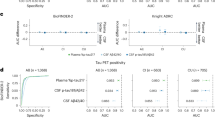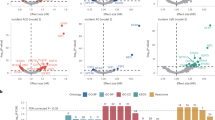Abstract
Study design
Diagnostic study.
Objective
Programmed cell death 10 (PDCD10) is a new versatile molecule involved in signal transduction regulation in angiogenesis and tumors. The potential of using it as a biomarker for the diagnosis of ankylosing spondylitis (AS) is still unknown.
Setting
University laboratory in Gannan Medical University, China.
Methods
Expression of PDCD10 was analyzed using clinical samples of patients with AS and Gene Expression Omnibus (GEO) data GDS5231. To explore its function, PDCD10 was upregulated and downregulated in synovial cells. Spearman analysis was used to study the association between PDCD10 and the Bath Ankylosing Spondylitis Disease Activity Index (BASDAI) and the modified Stoke Ankylosing Spondylitis Spinal Score (mSASSS). The Receiver operating characteristic (ROC) curve was applied to evaluate the sensitivity and specificity of PDCD10.
Results
Expression of PDCD10 was upregulated in patients with AS and it is capable of promoting the calcification of synovial cells. A positive association between PDCD10 and the BASDAI and the mSASSS was observed. The area under the ROC curve (AUC) of PDCD10 was 82% with a 95% confidence interval of [0.772, 0.868].
Conclusions
PDCD10 is upregulated in patients with AS and it can promote the calcification of synovial cells in vitro. PDCD10 is positively associated with outcome parameters of AS. ROC analysis of PDCD10 suggests that it can be used as a biomarker for the diagnosis and treatment of AS.
This is a preview of subscription content, access via your institution
Access options
Subscribe to this journal
Receive 12 print issues and online access
$259.00 per year
only $21.58 per issue
Buy this article
- Purchase on Springer Link
- Instant access to full article PDF
Prices may be subject to local taxes which are calculated during checkout




Similar content being viewed by others
Data availability
GDS5231 can be obtained from the NCBI network: https://www.ncbi.nlm.nih.gov/geoprofiles. Others are available on request.
References
Ebrahimiadib N, Berijani S, Ghahari M, Pahlaviani FG. Ankylosing spondylitis. J Ophthalmic Vis Res. 2021;16:462–9.
Braun J, Sieper J. Ankylosing spondylitis. Lancet. 2007;369:1379–90.
Sparks JA, Costenbader KH. Genetics, environment, and gene-environment interactions in the development of systemic rheumatic diseases. Rheum Dis Clin North Am. 2014;40:637–57.
Wang XB, Ellis JJ, Pennisi DJ, Song X, Batra J, Hollis K, et al. Transcriptome analysis of ankylosing spondylitis patients before and after TNF-alpha inhibitor therapy reveals the pathways affected. Genes Immun. 2017;18:184–90.
Poddubnyy D, Sieper J. Diagnostic delay in axial spondyloarthritis - a past or current problem? Curr Opin Rheumatol. 2021;33:307–12.
Sieper J, Poddubnyy D. New evidence on the management of spondyloarthritis. Nat Rev Rheumatol. 2016;12:282–95.
Bergametti F, Denier C, Labauge P, Arnoult M, Boetto S, Clanet M, et al. Mutations within the programmed cell death 10 gene cause cerebral cavernous malformations. Am J Hum Genet. 2005;76:42–51.
Valentino M, Dejana E, Malinverno M. The multifaceted PDCD10/CCM3 gene. Genes Dis. 2021;8:798–813.
Ørnbjerg LM, Brahe CH, Askling J, Ciurea A, Mann H, Onen F, et al. Treatment response and drug retention rates in 24 195 biologic-naive patients with axial spondyloarthritis initiating TNFi treatment: routine care data from 12 registries in the EuroSpA collaboration. Ann Rheum Dis. 2019;78:1536–44.
Wordsworth BP, Cohen CJ, Davidson C, Vecellio M. Perspectives on the genetic associations of ankylosing spondylitis. Front Immunol. 2021;12:603726.
Chen B, Li J, He C, Li D, Tong W, Zou Y, et al. Role of HLA-B27 in the pathogenesis of ankylosing spondylitis. Mol Med Rep. 2017;15:1943–51.
Pimentel-Santos FM, Mourão AF, Ribeiro C, Costa J, Santos H, Barcelos A, et al. Spectrum of ankylosing spondylitis in Portugal. Development of BASDAI, BASFI, BASMI and mSASSS reference centile charts. Clin Rheumatol. 2012;31:447–54.
Khanna M, Keightley A. MRI of the axial skeleton manifestations of ankylosing spondylitis. Clin Radiol. 2005;60:135–6.
Rudwaleit M, Khan MA, Sieper J. The challenge of diagnosis and classification in early ankylosing spondylitis: do we need new criteria? Arthritis Rheum. 2010;52:1000–8.
Creemers MC, Franssen MJ, van’t Hof MA, Gribnau FW, van de Putte LB, van Riel PL. Assessment of outcome in ankylosing spondylitis: an extended radiographic scoring system. Ann Rheum Dis. 2005;64:127–9.
Wang Y, Liu H, Zhang Y, Ma D. cDNA cloning and expression of an apoptosis-related gene, humanTFAR15 gene. Sci China C Life Sci. 1999;42:323–9.
Stahl S, Gaetzner S, Voss K, Brackertz B, Schleider E, Sürücü O, et al. Novel CCM1, CCM2, and CCM3 mutations in patients with cerebral cavernous malformations: in-frame deletion in CCM2 prevents formation of a CCM1/CCM2/CCM3 protein complex. Hum Mutat. 2008;29:709–17.
Cigoli MS, Avemaria F, De Benedetti S, Gesu GP, Accorsi LG, Parmigiani S, et al. PDCD10 gene mutations in multiple cerebral cavernous malformations. PLoS ONE. 2014;9:e110438.
Huang DN, Zhao HS. PDCD10,a novel signal transduction regulating molecule with multiple functions. Chin J Biochem Mol Biol. 2013;24:306–10.
Ma X, Zhao H, Shan J, Long F, Chen Y, Chen Y, et al. PDCD10 interacts with Ste20-related kinase MST4 to promote cell growth and transformation via modulation of the ERK pathway. Mol Biol Cell. 2007;18:1965–78.
Zhang H, Ma X, Deng X, Chen Y, Mo X, Zhang Y, et al. PDCD10 interacts with STK25 to accelerate cell apoptosis under oxidative stress. Front Biosci. 2012;17:2295–305.
Ranganathan V, Gracey E, Brown MA, Inman RD, Haroon N. Pathogenesis of ankylosing spondylitis - recent advances and future directions. Nat Rev Rheumatol. 2017;13:359–67.
Brown MA, Kenna T, Wordsworth BP. Genetics of ankylosing spondylitis–insights into pathogenesis. Nat Rev Rheumatol. 2016;12:81–91.
Danve A, O’Dell J. The ongoing quest for biomarkers in ankylosing spondylitis. Int J Rheum Dis. 2015;18:826–34.
Corr M. Wnt signaling in ankylosing spondylitis. Clin Rheumatol. 2014;33:759–62.
Yang PT, Xiao WG, Qin L, Zhao LJ, He LM, Ito M. A pilot study on changes of macrophage colony stimulating factor and transforming growth factor beta1 in male patients with ankylosing spondylitis taking thalidomide. Ann Rheum Dis. 2010;69:781–2.
Zhang H, Lin M, Dong C, Tang Y, An L, Ju J, et al. An MST4-pbeta-Catenin(Thr40) signaling axis controls intestinal stem cell and tumorigenesis. Adv Sci. 2021;8:e2004850.
Thompson BJ, Sahai E. MST kinases in development and disease. J Cell Biol. 2015;210:871–82.
Acknowledgements
All the authors would thank anonymous reviewers and the editor for improving our manuscript. This work was supported by the Key Laboratory of Prevention and Treatment of Cardiovascular and Cerebrovascular of Ministry of Education of Gannan Medical University (XN202013), Science and Technology Research Project of Jiangxi Provincial Department of Education (GJJ201528), Startup Foundation for Advanced Talents of Gannan Medical University (QD202124).
Author information
Authors and Affiliations
Contributions
Conceptualization and Data curation, WJN and XML; Funding acquisition, WJN and XML; Methodology, WJN; Project administration, XML; Supervision, XML; Writing-original draft, WJN; Writing-review & editing, WJN and XML.
Corresponding author
Ethics declarations
Competing interests
The authors declare no competing interests.
Ethics approval
Ethical approval was obtained from the Ethics Committee of Gannan Medical University (No. 2021241).
Additional information
Publisher’s note Springer Nature remains neutral with regard to jurisdictional claims in published maps and institutional affiliations.
Rights and permissions
Springer Nature or its licensor (e.g. a society or other partner) holds exclusive rights to this article under a publishing agreement with the author(s) or other rightsholder(s); author self-archiving of the accepted manuscript version of this article is solely governed by the terms of such publishing agreement and applicable law.
About this article
Cite this article
Ni, WJ., Leng, XM. Programmed cell death 10 can be used as a potential biomarker for ankylosing spondylitis diagnosis and treatment. Spinal Cord 62, 99–103 (2024). https://doi.org/10.1038/s41393-023-00952-9
Received:
Revised:
Accepted:
Published:
Issue Date:
DOI: https://doi.org/10.1038/s41393-023-00952-9



